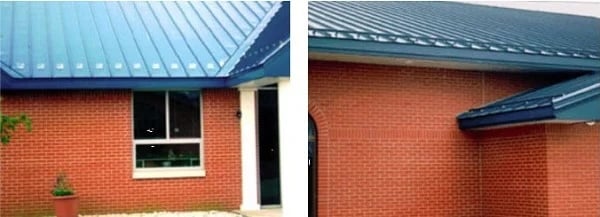ColorGard presents architecturally clean lines. It is unobtrusive in appearance, blending into the roofscape. When compared to plastic alternatives that have highly reflective characteristics, ColorGard is the clear winner for complementing the roof.
Clear plastic alternatives are often presented as being inconspicuous. Manufacturers claim that they are “practically invisible” due to their “colorless transparency”.

“Clear” plastic snow guards (left) vs. ColorGard on matching roof (right). Which one is really less conspicuous?
What manufacturers neglect to say is that these plastics are petroleum derivatives that change as they age. The sun’s ultraviolet rays draw out the oils and plasticizers leach out of the material causing the material to yellow with time.
 A few short years in the elements causes clear plastic to dramatically discolor.
A few short years in the elements causes clear plastic to dramatically discolor.
Because these products generally have low load-to-failure values, they must often be used in a very redundant fashion to avoid overload and failure. Because of ColorGard’s Herculean strength, less ColorGard is required. Based on lab-tested load-to-failure data, it can take up to 10 plastic parts to equal the strength of just one row of ColorGard.

The appearance of these buildings is marred by roofs “polka-dotted” with clear plastic snow retention devices.
Because these products generally have low load-to-failure values, they must often be used in a very redundant fashion to avoid overload and failure. But because of ColorGard’s Herculean strength, less ColorGard is required. It can take up to 10 plastic parts to equal the strength of just one row of ColorGard. Learn more about the ColorGard system for standing seam and exposed-fastened metal roofing here.
